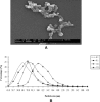Liposome-based vascular endothelial growth factor-165 transfection with skeletal myoblast for treatment of ischaemic limb disease
- PMID: 18681907
- PMCID: PMC3837621
- DOI: 10.1111/j.1582-4934.2008.00454.x
Liposome-based vascular endothelial growth factor-165 transfection with skeletal myoblast for treatment of ischaemic limb disease
Abstract
The study aims to use cholesterol (Chol) + DOTAP liposome (CD liposome) based human vascular endothelial growth factor-165 (VEGF(165)) gene transfer into skeletal myoblasts (SkMs) for treatment of acute hind limb ischaemia in a rabbit model. The feasibility and efficacy of CD liposome mediated gene transfer with rabbit SkMs were characterized using plasmid carrying enhanced green fluorescent protein (pEGFP) and assessed by flow cytometry. After optimization, SkMs were transfected with CD lipoplexes carrying plasmid-VEGF(165) (CD-pVEGF(165)) and transplanted into rabbit ischaemic limb. Animals were randomized to receive intramuscular injection of Medium199 (M199; group 1), non-transfected SkM (group 2) or CD-pVEGF(165) transfected SkM (group 3). Flow cytometry revealed that up to 16% rabbit SkMs were successfully transfected with pEGFP. Based on the optimized transfection condition, transfected rabbit SkM expressed VEGF(165) up to day 18 with peak at day 2. SkMs were observed in all cell-transplanted groups, as visualized with 6-diamidino-2-phenylindole and bromodeoxyuridine. Angiographic blood vessel score revealed increased collateral vessel development in group 3 (39.7 +/- 2.0) compared with group 2 (21.6 +/- 1.1%, P < 0.001) and group 1 (16.9 +/- 1.1%, P < 0.001). Immunostaining for CD31 showed significantly increased capillary density in group 3 (14.88 +/- 0.9) compared with group 2 (8.5 +/- 0.49, P < 0.001) and group 1 (5.69 +/- 0.3, P < 0.001). Improved blood flow (ml/min./g) was achieved in animal group 3 (0.173 +/- 0.04) as compared with animal group 2 (0.122 +/- 0.016; P= 0.047) and group 1 (0.062 +/- 0.012; P < 0.001). In conclusion, CD liposome mediated VEGF(165) gene transfer with SkMs effectively induced neovascularization in the ischaemic hind limb and may serve as a safe and new therapeutic modality for the repair of acute ischaemic limb disease.
Figures
















Similar articles
-
Angiomyogenesis using liposome based vascular endothelial growth factor-165 transfection with skeletal myoblast for cardiac repair.Biomaterials. 2008 May;29(13):2125-37. doi: 10.1016/j.biomaterials.2008.01.014. Epub 2008 Feb 14. Biomaterials. 2008. PMID: 18279953
-
Nanoparticle based delivery of hypoxia-regulated VEGF transgene system combined with myoblast engraftment for myocardial repair.Biomaterials. 2011 Mar;32(9):2424-31. doi: 10.1016/j.biomaterials.2010.12.008. Epub 2011 Jan 8. Biomaterials. 2011. PMID: 21216458
-
Transplantation of nanoparticle transfected skeletal myoblasts overexpressing vascular endothelial growth factor-165 for cardiac repair.Circulation. 2007 Sep 11;116(11 Suppl):I113-20. doi: 10.1161/CIRCULATIONAHA.106.680124. Circulation. 2007. PMID: 17846290
-
Autologous skeletal myoblasts transduced with a new adenoviral bicistronic vector for treatment of hind limb ischemia.J Vasc Surg. 2004 Oct;40(4):774-85. doi: 10.1016/j.jvs.2004.07.027. J Vasc Surg. 2004. PMID: 15472608
-
[Experimental study on treatment of acute limb ischemia with vascular endothelial growth factor-121 gene transfer].Zhongguo Xiu Fu Chong Jian Wai Ke Za Zhi. 2004 Mar;18(2):142-5. Zhongguo Xiu Fu Chong Jian Wai Ke Za Zhi. 2004. PMID: 15065417 Chinese.
Cited by
-
Skeletal myoblasts for cardiac repair.Regen Med. 2010 Nov;5(6):919-32. doi: 10.2217/rme.10.65. Regen Med. 2010. PMID: 21082891 Free PMC article. Review.
-
Therapeutic angiogenesis: controlled delivery of angiogenic factors.Ther Deliv. 2012 Jun;3(6):693-714. doi: 10.4155/tde.12.50. Ther Deliv. 2012. PMID: 22838066 Free PMC article. Review.
References
-
- Labs KH, Dormandy JA, Jaeger KA, et al. Transatlantic conference on clinical trial guidelines in peripheral arterial disease: clinical trial methodology. Circulation. 1999;100:e75–81. - PubMed
-
- Dormandy JA, Rutherford RB. Management of peripheral arterial disease (PAD). TASC Working Group. TransAtlantic Inter-Society Concensus (TASC) J Vasc Surg. 2000;31:S1–296. - PubMed
-
- Weitz JI, Byrne J, Clagett GP, et al. Diagnosis and treatment of chronic arterial insufficiency of the lower extremities: a critical review. Circulation. 1996;94:3026–49. - PubMed
-
- Niagara MI, Haider Kh H, Ye Lei, et al. Autologous skeletal myoblasts transduced with a new adenoviral bicistronic vector for treatment of hind limb ischemia. J Vasc Surg. 2004;40:774–85. - PubMed
-
- Bobek V, Taltynov O, Pinterova D, et al. Gene therapy of the ischemic lower limb-Therapeutic angiogenesis. Vasc Pharmacol. 2006;44:395–405. - PubMed
Publication types
MeSH terms
Substances
LinkOut - more resources
Full Text Sources
Other Literature Sources

